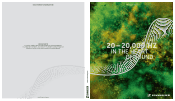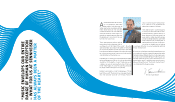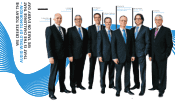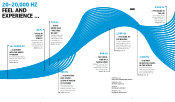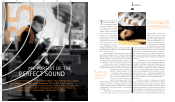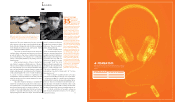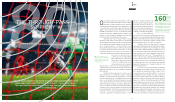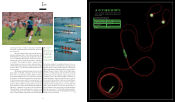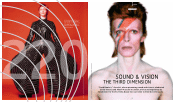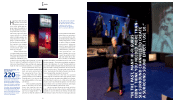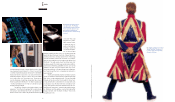Sennheiser 2012 Annual Report Download - page 8
Download and view the complete annual report
Please find page 8 of the 2012 Sennheiser annual report below. You can navigate through the pages in the report by either clicking on the pages listed below, or by using the keyword search tool below to find specific information within the annual report.
14
80 Hz
SOUND SOCCER
tacts begin to take on Modise’s exact beat. The techno
trance-like sounds would be just as likely to be heard on a
disco dance floor.
The women gripe a little, but the men like the music.
One time, the players listen to time-synchronized music and
they literally move at the same rate. The next time, the mu-
sic is on a slight time delay. After 22 training sessions full of
tackles, passes, shots and goals, the researchers’ assumption
is confirmed. The manager was able to observe how the
team listening to synchronous acoustics was better able to
carry through long-pass sequences. Passes were also quicker
and more direct – just the right sprinkling and they even
shot more goals.
The amazing results quickly generate interest in the
upper leagues. Football has continued to evolve since Mara-
dona’s time – it’s gotten faster and more athletic. A tremen-
dously talented player has less to do with success than the
performance of a perfectly tuned team. The top internation-
al clubs have been using scientific training methods for a
long time now. For instance, AC Milan operates the MilanLab
and its soundproof Mind Room, where players go to improve
their concentration using visual mental training. The Bundes-
liga has also caught up in recent years, but visual methods
still predominate. The acoustical approach of sound soccer is
something totally new for most teams. Prof. Effenberg main-
tains acoustical training is significant and forward-looking.
In the future, he wants to use high-tech insoles to more ac-
curately measure the football players’ step sequences and
ground contacts in order to gain information on the players’
dribbling and tackles. Using this method, it was even able to
decipher the magic formula of FC Barcelona’s brilliant game.
In 2007, its prodigy and superstar Lionel Messi recreated
Maradona’s goal of the century in a game against a local
football association. When Manfred Müller sonified this cel-
ebrated dribbling, he found something miraculous. “Messi is
one of a kind,” marvels Müller. “He moves in three different,
overlapping rhythms and is the only one able to achieve a
sequence of ground and ball contacts of over 160 bpm.” But
even a genius like Messi can only excel with the help of a
functioning team. Messi’s performances with the Argentine
national team are proof of that. Without glistening team-
work, Messi won’t shine, either. Maybe Argentina should give
sound soccer a try sometime.
c1. “Ta! Ta! Ta!
Goooooool!” –
Maradona’s goal of
the century during
the 1986 World
Cup. f2. “Rudders,
long!” – sonifica-
tion improves the
motion sequences
of scullers as well.
j OCX 685i SPORTS
Sweat- and water-resistant headset with perfect
noise cancelation, integrated microphones and
remote control.
Sennheiser OCX 685i Sports
Ergonomic training headset
Frequency response 18–20,000 Hz
Sensitivity (121 TR9-5) -44 dB V/Pa
Total harmonic
distortion
≤ 0.5 %
Weight 15 g

